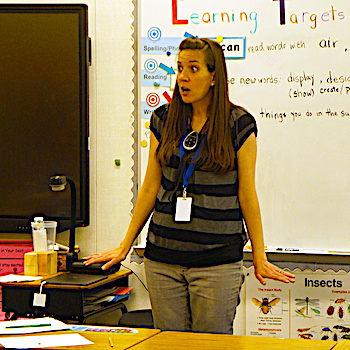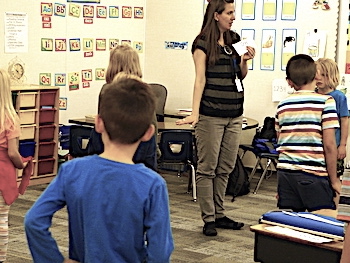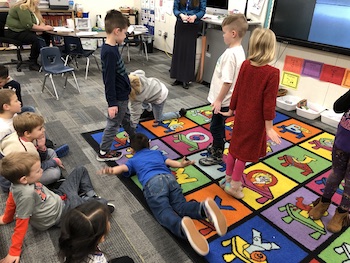SUBJECTS
GRADE
Show Results
Waddling Ones and Tobogganing Tens

Lesson Summary
- Connect music and math terms through movement.
- Create lyrics based on tens and ones.
- Explore multiple ways to represent numbers.
Lesson Plan and Procedure
Lesson Key Facts
- Grade(s): K, 1, 2
- Subject(s): Dance, Math, Music
- Duration of lesson: Two sessions, 30-45 minutes each
- Author(s): Emily Soderborg
Session One
Connecting Using Review
Play the number 23 on the drum and glockenspiel by sliding across bars of the glockenspiel two times and beating the drum three times. Have students use the quick-draw method and draw tens on their whiteboards as lines, and ones as dots. Ask students to describe the timbre of the instruments.
Teacher: How would you describe the sound of the drum? Can you use one word to describe its sound? (Boom, bang, or tap are possible ideas if students need suggestions.)
Teacher: The word helps describe the instrument timbre. Other things we can describe the sound with are the length, pitch, and volume. Let's think together. Is the drum sound a long sound (the sound itself goes on a long time), or a short sound (the sound ends really fast)? Is it a high or low sound? A loud or a soft sound?
Teacher: How about the glockenspiel? What one word would you use to describe the timbre/sound of the glockenspiel? (Possible words might include ding, chime, brrrring, and so on.) When I play the bars, does the sound last longer or shorter than the sounds on the drum? Is it higher or lower than the drum? What is the same about these two instruments? (Possible answers could include these: both instruments are played with mallets, and both are in the percussion instrument family.)
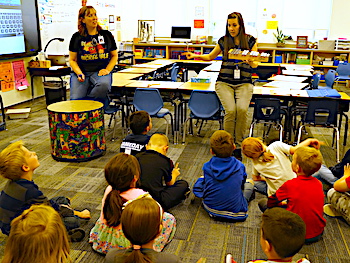
Teacher: When I play the drum, are the sounds separate or connected? How about the glockenspiel, especially when I glissando, or slide across the bars?
Teacher: There are musical terms to help us describe these separated sounds and connected sounds. The short, separate sounds are called staccato. The smooth, connected sounds are called legato. Our ones, played on the drum, have been staccato, and our tens, played on the glockenspiel, have been more legato. Let's think about how we moved as we were dancing last time. Our ones were percussive, which is another way of saying staccato. Our tens were sustained, which is another way of saying legato.
When talking about hundreds in second grade, it can be compared to harmony. The harmony is when more than one note is playing at the same time. The piano or autoharp plays chords, which means that more than one note is playing at the same time, which creates harmony.
Penguins Waddle and Slide
Teacher: Today we are going to watch a video of penguins and the way they move. As you watch the video, think about how the penguins' movements could be described by the words staccato and legato, as well as percussive and sustained.
Watch the video showing penguin movements: https://www.youtube.com/watch?v=O8qilxaBR20 (start at 3:30)
Or https://www.youtube.com/watch?v=CkMzHGA8GgM
For second grade, watch this movie also: https://www.youtube.com/watch?v=snAvGxz7D04 (includes information about swimming and coming up out of the water)
Teacher: Did you notice that penguins waddle or hop when they take steps? They can only take small, individual steps when they walk. Their steps seem a little disconnected, or staccato. And just as the penguins can only take one step at a time, when we count by ones, we can only count individual numbers. However, penguins have figured out a faster way to move on land, called tobogganing. If the penguins slide on the ice, they can go faster and farther. Their movements while tobogganing are smooth, or legato and sustained. The way the penguins toboggan on ice is like when we count by tens instead of by ones. When we count by tens, we can count faster and get to our end number sooner.
Teacher: We're going to play a game in which you will get to waddle individual steps when I count by ones. However, when I count by tens, you aren't going to slide on your bellies, because there isn't any ice in our classroom. Instead, you will slide on your feet (sashay) around the room. Watch how I do it.
Have students watch you model a couple of numbers.
Teacher: When I hold up the "tens" vocabulary card, you get to slide. When I hold up the "ones" vocabulary card, you will waddle.
Count out loud as you slide for the tens and waddle for the ones, modeling the game for the students. Use the numbers 43 and 67.
Teacher: My first number is 43. Tens: 10, 20, 30, 40. . . . Ones: 41, 42, 43.
Teacher: My second number is 67. Tens: 10, 20, 30, 40, 50, 60. . . . Ones: 61, 62, 63, 64, 65, 66, 67.
Note: There are many possible extensions to the game. If students are ready, mix up the tens and ones to reinforce counting on from a number. Or you can add ten more to the number stopped on. Most will be ready after a few exposures to count by ones up to a multiple of ten.
Teacher: Ready to waddle and slide? Find your own space in the room, not touching anyone else. Ready? The number is 36! Tens: 10, 20, 30. . . . Ones: 31, 32, 33, 34, 35, 36.
Play for five to ten minutes, as long as the students are attentive. Playing the drum for ones, the glockenspiel/xylophone/barred instrument for tens, and the autoharp/piano for hundreds will add another level of musical depth to the movement activity.
Second Grade
For the hundreds place, the students will move by jumping (long jump style) and using their arms to act like they are swimming in the ocean. They have to move both their legs and their arms (this ties back into the concept of harmony, with more than one note happening at the same time.) An example of a number would be 458.
Teacher: Our number today is 458! Hundreds: 100, 200, 300, 400. . . . Tens: 410, 420, 430, 440, 450. . . . Ones: 451, 452, 453, 454, 455, 456, 457, 458. (The teacher would model four long jumps with swimming arms, five slides, and eight waddle steps.)
Extension idea: Do the process backwards, and have half the students watch and figure out what number the other half just showed through movement, and show it in a quick draw.
Composing Place-Value Lyrics
Help students create a composition about what they know about showing numbers as tens and ones to the tune "Johnny Works with One Hammer."
Teacher: Let's discuss what we know about the ones place and the tens place in regards to place value. Tell me things you know about ones. (E.g., individual units, use digits 0-9, only 9 or less can be in the ones column.) Tell me things you know about tens. (E.g., tens are a group of ten ones, tens help us count faster, counting by tens we skip the numbers in between the multiples of ten.)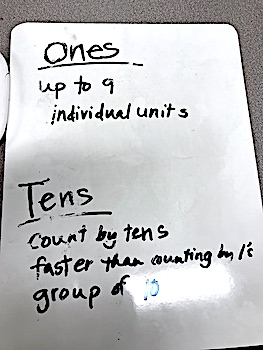 Listen to the students' wording, and write down their main ideas.
Listen to the students' wording, and write down their main ideas.
Teacher: We are going to use what we know about tens and ones to help us come up with lyrics that fit with the melody for "Johnny Works with One Hammer." Let's sing through the song once to get the melody in our minds.
Take student suggestions and use their words to create new lyrics that fit with the melody. Possible ideas of lyrics are listed below. Teachers may use the lyrics written in this lesson plan, but the students will remember their lyrics better if they come up with them by themselves. (And they usually come up with better, more meaningful ideas on their own.)
Ones are the individuals, individuals, individuals
Ones are the individuals in a number
Tens help us group and count faster, group and count faster, group and count faster,
Tens help us group and count faster all our numbers
OR
The ones place holds the single units, single units, single units
The ones place holds the single units-up to nine
The tens place holds the groups of ten, groups of ten, groups of ten
The tens place holds the groups of ten-three groups of ten is 30
After writing the lyrics, sing through all of the verses, then sing the ones verse with short, staccato articulation, and sing the tens verse with smooth, legato articulation.
In second grade, with the hundreds verse, add harmony to the singing. Have half the class sing the note "C" the entire time on a neutral syllable, such as "oh," while the other half of the class sings the words. (This is called a drone. When singing a drone, the students will need to breathe often, every four beats or so, so they stay in tune with each other. When they don't breathe often enough, the pitch they are singing can drop.) The first time partnering a melody with a drone harmony, it is good for the students to all sing together while the teacher sings the drone first, so they can hear what it is supposed to sound like and have each other as a support to keep singing the words.
Session Two
Vocabulary Review
Start by singing and playing the song game "Johnny Works with One Hammer" (the regular version of the game). After playing the game, review the new verses the students wrote in session one.
Using a hand or stick puppet, review the unit's math vocabulary words.
Puppet: I'm so excited to see you again. Could you help me remember what the math vocabulary words mean?
Teacher (to the puppet): Why don't you help us read the words? Everyone read together: "digit," "tens," "ones," and "place value".
Puppet: What is a digit? What are ones? What are tens? What is place value?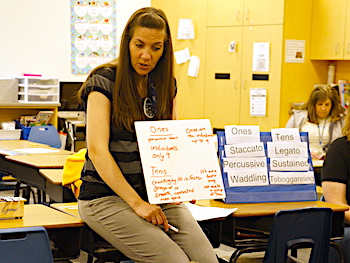
Puppet: I heard you singing some songs while I was sitting here today. Would you sing them for me again?
Teacher: Let's show our friend how we can sing the ones verse staccato.
Puppet: Before you sing, please tell me what staccato means.
Teacher: Who can tell our friend what staccato means?
Call on a student to define staccato. (I.e., Short, disconnected notes.) Have the class sing the ones verse staccato.
Teacher: What other words have we been connecting with the ones, besides the word staccato? (E.g, percussive, waddle, drum.)
Teacher: We also learned another new music word, legato. Who can tell our puppet friend what legato means? (I.e., smooth and connected notes.) Let's sing our tens verse legato as the puppet listens.
Sing the tens verse legato. Ask what other words connect with the tens (sustained, toboggan/slide, glockenspiel/xylophone). Arrange the word cards either in a second column on the floor or in a pocket chart, so students can visually see the connections.
Representing Numbers Multiple Ways
On a board use a quick draw to show the number 34.

Teacher: What number did I represent using this quick draw? Is there one person who thinks that he or she could draw a different picture to show the number 34 in another way, either as all ones or using a combination of ones and tens?
Have a student come draw an alternate representation.

Teacher: Is there a third way to draw the number 34 as a picture?
If a student has an idea, let him or her come show it. (If not, draw another way yourself.)
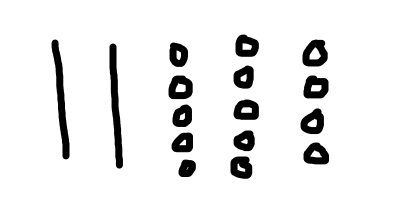
Teacher: Which quick draw is easiest to read? For me the easiest one has three lines representing tens and four dots representing ones.
Teacher: Look at the quick draw for 34. Let's waddle and toboggan to represent this first quick draw. Make sure to count out loud.
The students should slide three times while counting 10, 20, 30 and then waddle four times while counting numbers 31, 32, 33, 34.
Teacher: Let's try to waddle and toboggan based on the second drawing we have. (Have them move to represent the second then third quick-draw pictures while counting out loud.)
Teacher: Let's try this with a new number. Our number will be 23. We're going to all move together, showing the tens first, then the ones. Make sure you continue counting out loud.
Students dance the number by sliding two times and waddling three times, while counting out loud.
Teacher: Think of a different way you could show this number with tobogganing and waddling, using either all ones or a different combination of tens and ones.
Once they have all tried moving, have half the class sit and watch while the other half performs. Those performing should count out loud as they toboggan and waddle around the room. Once they get to 23, they should freeze in an interesting penguin shape until all of the students have finished showing their number. Switch group roles so the other group gets to perform before discussing the movements.
Teacher: Now that everyone has had the chance to perform, think back to what you saw. What ways did you see other students showing the number 23 with their bodies? Which ways were the easiest to keep track of the counting? Which was the fastest way to get to the number? Which took the longest?
Give the students one last number to dance (40). First, dance the number all together as a class, with students making their own decisions of how to represent the number through waddling and tobogganing. Then, using the same procedures as above, have the students perform for each other, but this time have the group that performed second go first.
Gather the students and ask the same questions about dancing this number as when they danced 23. As the students describe how they saw the number 40 danced, quick-draw to document the various students' movements of the number.
Teacher: Please select all the ways that correctly name this model from the following options: 40, 40 tens, 40 ones, or 4 tens and 0 ones.
Go through each answer, and have students give a thumbs-up if it correctly names the model, or a thumbs-down if it doesn't correctly name the model. All of the answers are correct, except for 40 tens.
Teacher: Help me write the number 40 in our sentence frame.
_______tens ______ones
_______+_______ = _______
Sing the students' ones verse to the tune "Johnny Works with One Hammer" using staccato notes and the tens verse using legato notes as a culminating experience for this unit.
Learning Objectives
- Understand that the two digits of a two-digit number represent amounts of tens and ones.
- Compare different timbres of instruments.
- Demonstrate locomotor movements.
- Explore movement inspired by penguins and math concepts.
- Demonstrate locomotor movements
Utah State Board of Education Standards
This lesson can be used to meet standards in many grades and subject areas. We will highlight one grade’s standards to give an example of application.
Grade 1 Mathematics
- Standard 1.MP.4: Model with mathematics. Identify the mathematical elements of a situation and create a mathematical model that shows the relationships among them. Identify important quantities in a contextual situation, use mathematical models to show the relationships of those quantities, analyze the relationships, and draw conclusions. Models may be verbal, contextual, visual, symbolic, or physical.
- Standard 1.MP.7: Look for and make use of structure. Recognize and apply the structures of mathematics such as patterns, place value, the properties of operations, or the flexibility of numbers. See complicated things as single objects or as being composed of several objects
- Standard 1.NBT.2: Understand that the two digits of a two-digit number represent amounts of tens and ones. Understand the following as special cases:
- 10 can be thought of as a bundle of ten ones, called a "ten."
- The numbers from 11 to 19 are composed of a ten and one, two, three, four, five, six, seven, eight, or nine ones.
- The numbers 10, 20, 30, 40, 50, 60, 70, 80, 90 refer to one, two, three, four, five, six, seven, eight, or nine tens (and 0 ones).
Grade 1 Music
- Standard 1.M.CR.1: Generate musical ideas for a specific purpose using limited tone sets and simple meters.
Grade 1 Dance
- Standard 1.D.P.1: Demonstrate moving safely through the space using a range of activities and in and out of spatial arrangements while maintaining personal space.
- Standard 1.D.P.4: Demonstrate locomotor and non-locomotor movements.
- Standard 1.D.CO.2: Describe and demonstrate movements organized around a specific topic.
Equipment and Materials Needed
- Drum with mallet (any size frame drum will work for this lesson)
- Barred instrument with mallet (glockenspiel, xylophone, or tone bells are all good options)
- Vocabulary cards
- Video(s) showing penguin movements:
https://www.youtube.com/watch?v=O8qilxaBR20 (start at 3:30) or possibly https://www.youtube.com/watch?v=CkMzHGA8GgM - For second grade, possibly watch this movie also:
https://www.youtube.com/watch?v=snAvGxz7D04 (includes information about penguins swimming and how fast they can go coming up out of the water) - Individual white boards, dry-erase markers, and erasers for each student
Additional Resources
- This lesson is part of a unit using the arts to teach place value. The lessons can be found on the BYU ARTS Partnership website. The titles include the following:
Image References
Images 1–4: Dianne Amesse.
Image 5: Emily Soderborg.
Image 6: Dianne Amesse.
Image 7: Lisa Garner.

www.education.byu.edu/arts/lessons
 Download
Download